I have a custom annotation for my mapView. I initially set the coordinate, title (eg. "first title"), subTitle (eg. "first address"), userId, and a distance (eg. 0 meters) property on it with some data. I add it to the mapView and to an array for later use. Everything works, it shows on the mapView, I press it and the callout shows that initial data.
I later get updated that the location for that callout has changed. I loop through the array and update the callout with new data for the coordinate, title (eg. "new title"), subTitle (eg. "new address"), and distance (eg. 100 meters) properties. I also animate the callout from it's original location to it's new location. The animation works fine and the callout moves from point A to point B.
The problem is when I tap the annotation the old data gets shown on the callout instead of the new data.
I use calloutAccessoryControlTapped to push on a new vc. When i put a breakpoint there the custom pin has all the new data. The error seems to happen with the callout.
How do I fix this?
I don't want to clear all the annotations from the mapView so that's not an option. I call mapView.removeAnnotation(customPin) and mapView.addAnnotation(customPin) which fixes the problem for that pin but there is a blink when the pin is removed and added back to the map and then when it animates to it's new location it looks choppy.
Custom Annotation
class CustomPin: NSObject, MKAnnotation {
@objc dynamic var coordinate: CLLocationCoordinate2D
var title: String?
var subtitle: String?
var userId: String?
var distance: CLLocationDistance?
init(coordinate: CLLocationCoordinate2D, title: String, subtitle: String, userId: String, distance: CLLocationDistance?) {
self.coordinate = coordinate
self.title = title
self.subtitle = subtitle
self.userId = userId
self.distance = distance
super.init()
}
}
First time the annotation gets set with initial data
firstFunctionThatGetsTheInitialLocation(origLat, origLon) {
let firstCoordinate = CLLocationCoordinate2DMake(origLat, origLon)
let distanceInMeters: CLLocationDistance = self.center.distance(from: anotherUsersLocation)
let customPin = CustomPin(coordinate: firstCoordinate, title: "first title", subtitle: "first address", userId: "12345", distance: distance)
DispatchQueue.main.async { [weak self] in
self?.mapView.addAnnotation(customPin)
self?.arrOfPins.append(customPin)
}
}
Second time the annotation gets set with New Data
secondFunctionThatGetsTheNewLocation(newCoordinate: CLLocationCoordinate2D, newDistance: CLLocationDistance) {
for pin in customPins {
pin.title = "second title" // ** updates but the callout doesn't reflect it
pin.subTitle = "second address" // ** updates but the callout doesn't reflect it
pin.distance = newDistance // ** updates but the callout doesn't reflect it
// calling these gives me the new data but the annotation blinks and moves really fast to it's new location
// mapView.removeAnnotation(pin)
// mapView.addAnnotation(pin)
UIView.animate(withDuration: 1) {
pin.coordinate = newCoordinate // this updates and animates to the new location with no problem
}
}
}
MapView viewFor annotation
func mapView(_ mapView: MKMapView, viewFor annotation: MKAnnotation) -> MKAnnotationView? {
if annotation.isKind(of: MKUserLocation.self) { return nil }
guard let annotation = annotation as? CustomPin else { return nil }
let reuseIdentifier = "CustomPin"
var annotationView = mapView.dequeueReusableAnnotationView(withIdentifier: reuseIdentifier)
if annotationView == nil {
annotationView = MKAnnotationView(annotation: annotation, reuseIdentifier: reuseIdentifier)
annotationView?.canShowCallout = true
annotationView?.calloutOffset = CGPoint(x: -5, y: 5)
annotationView?.rightCalloutAccessoryView = UIButton(type: .detailDisclosure)
annotationView?.image = UIImage(named: "chevronImage")
} else {
annotationView?.annotation = annotation
}
annotationView?.detailCalloutAccessoryView = nil
annotationView?.detailCalloutAccessoryView = createCallOutWithDataFrom(customPin: annotation)
return annotationView
}
Creation of UIView for Callout
func createCallOutWithDataFrom(customPin: CustomPin) -> UIView {
let titleText = customPin.title
let subTitleText = customPin.subTitle
let distanceText = subTitle.distance // gets converted to a string
// 1. create a UIView
// 2. create some labels and add the text from the title, subTitle, and distance and add them as subViews to the UIView
// 3. return the UIView
}
